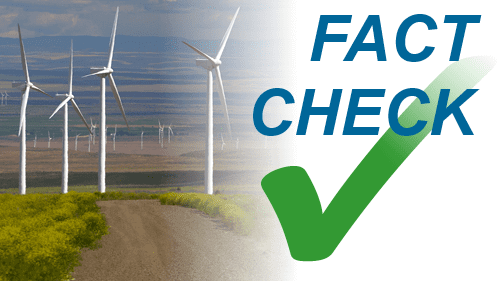Fact check: LA Times off target on renewables, reliability
The reality is that large amounts of wind energy are being reliably integrated onto the power system today. Iowa and South Dakota already reliably produce more than 20% of their electricity from wind energy, and another seven states reliably produce more than 10%. At one point earlier this year, wind energy provided 35% of the electricity on the main Texas grid, while at another point more than 60% of the electricity of the main Colorado utility system came from wind energy.

Dozens of in-depth wind integration studies, including several by the California grid operator, have confirmed that far larger amounts of wind energy can be added to the power system without harming reliability. As noted in the article, grid upgrades and reforms to make grid operating procedures more efficient are helping that transition, though the article fails to note that those upgrades were needed anyway to bring our obsolete power grid into the 21st century. Numerous studies confirm that these upgrades will more than pay for themselves even in the absence of wind energy by improving electric reliability, providing consumers with access to lower cost energy, and making the grid and electricity markets more efficient.
Wind energy is reliably integrated using the same tools that grid operators have used for decades to accommodate sudden failures at conventional power plants, as well as constant fluctuations in electricity demand. In fact, it is far more appropriate to talk about the need to back up large fossil and nuclear power plants, as those are the generators that experience large, immediate, and unexpected outages, requiring grid operators to keep 1000+ MW of fast-acting and expensive standby generation ready 24/7/365.
In contrast, changes in wind and solar energy output occur slowly, as it typically takes hours for a weather event to change the aggregate output of renewable plants that are spread over a large geographic area. Because of this and the fact that wind and solar output can be predicted using weather forecasting while conventional generator outages are unpredictable, grid operators can accommodate wind and solar with slower types of reserve generation at a fraction of the cost of the fast reserves used to accommodate fossil and nuclear plant outages.
A powerful illustration of this fact came in February 2011, when millions of homes and businesses in Texas suffered rolling blackouts because some 100 fossil-fired power plants broke down due to cold weather. Those rolling blackouts would have been significantly worse had wind energy not kept producing at and above the levels the utility system operator was expecting, providing enough power to keep the lights on for millions of Texas residents. Following that event, the head of the Texas system operator explicitly commended wind energy for its role in helping to keep the lights on.
It is telling that to create his “the sky is falling” narrative, Mr. Halper had to reference blackouts that were not caused by renewable energy, as there simply aren’t any renewable energy reliability incidents to point to. The reliable track record of renewables is clear, something that cannot be said for most other energy sources.
Related articles:
Fact check: Sorgo's Holly wildly exaggerates cost of wind power, October 29, 2013
Independent grid operator study confirms wind power's economic, environmental value, October 29, 2013
Fact check: Fossil-funded think tank unreliable on reliability, October 9, 2013
Fact check: Wind power benefits consumers and environment, in Germany and U.S., September 20, 2013
Correcting fossil fuel industry misinformation about Germany's success with renewable energy, September 10, 2013
Fact check: Correcting math errors leads back to original finding: Wind power is affordable, reliable, August 20, 2013
Fact check: NYT story misses larger story of wind's reliability, August 15, 2013
Doubling down on wind: Ireland greens its grid, looks to export, July 3, 2013
New report further confirms renewable energy is reliable, April 18, 2013
Utility system in NE Vermont to be strengthened, resolving concerns about new wind power, April 10, 2013
Fact check: Debunking Howard Rich's errors on wind, March 28, 2013
Fact check: Sen. Alexander's claims about wind energy unfounded, March 27, 2013
Xcel Energy achieves wind energy milestone, March 26, 2013
Fact check: WSJ goes astray on California's integration of wind, February 28, 2013
Lesser misstates facts at Heritage-Exelon anti-wind briefing, November 30, 2012
Fact check: 'Green Illusions' ill-informed about wind power, July 5, 2012
Fact check: Bell missteps on utility integration of wind power, May 24, 2012
Fact check: Bryce whiffs on wind power and Texas heat wave, August 12, 2011




